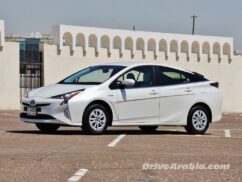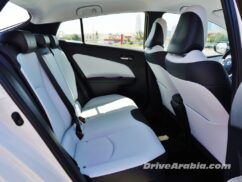2016 Toyota Prius

| The Good: – Futuristic vibe inside and out – Saves fuel as advertised – Rides and drives pretty well |
The Bad: – Styling too oddball for some – Aging navigation graphics – Some hard cabin plastics |
The Toyota Prius is practically the definition of a hybrid car. Debuting nearly two decades ago as a generic-looking compact, it wasn’t until the iconic second and third generations that it really caught the world’s imagination and the scorn of car enthusiasts. They also became known for being slow and boring to drive. Clearly Toyota wanted to do something about that, and the all-new 2016 Prius looks like no Prius before it. Also, this new model marks the Prius’ debut in the GCC, so we were rather excited to try it out and see what all the negativity was about. As some in the local car industry would say, we are all about the negativity.
Now, we’re not sure who Toyota is trying to target with the new styling, but you’d be lucky to find anyone who thinks the new Prius looks good. We can even see “leading” automotive journalists tiptoeing around the subject instead of bringing it up. The fact is the design is unresolved, and tries too hard to stand out for a tall compact with small wheels. However, there are some amazing design details, such as the sculpted tail lights and the glitter effect on the LED headlights that need to be seen in person to be appreciated. And frankly, we enjoyed trundling around in the Prius, as we like cars that turn heads, even if controversially. We prefer Toyota take such design risks rather than just facelift Land Cruisers for a decade.

Inside, the dashboard is stunningly futuristic, at least in the white-black colour combo our top-spec “Iconic” test car had. The upper panels consist of leatherette that matches the excellent seat upholstery, mildly-padded hard plastics, polished-to-a-shine hard plastics, some soft-touch surfaces and well-padded armrests, so the ambience never feels cheap. An interesting feature is the tiny overhead LED bulb that lights up the centre-console area at night without being distracting.
Below the world’s smallest gear-shifter, a cubby doubles as a wireless phone charger, although it didn’t work with our phone. With the central full-colour LCD display on top of the dash, a “floating” capacitive touchscreen in the centre-console with touch buttons along the sides, and the heads-up display on the windshield, it feels like you’re driving the automotive equivalent of an iPhone.
Of course, that vibe lasts as long as you don’t look at the 80s-style LCD displays for the clock and the dual-zone a/c. And while the touchscreen works well, with big icons and clear text, the navigation system still features graphics from half-a-decade ago, when others have moved on to more 3D-style maps. We did like the dash-top display though, which shows what the battery, electric motor and petrol engine are doing, and in which direction the energy is flowing. Also, the speedo in the middle of the dash didn’t matter much, as the heads-up display made up for it. Other features include the good CD/MP3/USB stereo, very good a/c but with no rear vents, and all the usual power-operated basics, but no sunroof. Safety features include the usual front/side/curtain airbags, ESP, ABS, blind-spot monitoring with cross-traffic alert, tyre-pressure warning, and a rearview camera with guidance lines and sensors.
Cabin space is good for a compact car, with well-bolstered front seats, although the Corolla offers better rear legroom. However, the Prius offers the practicality of a hatchback-style lid for its good-sized boot. There are enough cup-holders and pockets too.

The Prius comes with a 1.8-litre 4-cylinder “Atkinson Cycle” engine making 97 hp at 5200 rpm and 142 Nm of torque at 3600 rpm. It is backed up by an electric motor/generator system offering 71 hp and 163 Nm of instant torque. That adds up to a combined total of 121 hp somehow, while there is no mention of a total torque figure, due to the offbeat nature of how the “Hybrid Synergy Drive” system works. Power is sent to the front wheels via a CVT automatic.
The 0-100 kph run was accomplished in 10.5 seconds during our March test, but don’t be fooled by the overall Corolla-like acceleration figure. The Prius has pretty good mid-range kick, so speed picks up well enough for quick overtaking and for jumping into roundabouts. There is power when you need it the most, and it feels like a much quicker car in daily driving, probably helped along with bursts of electric power and a responsive transmission that picks the optimal revs without sounding drony like most other CVT cars.
There are several driver settings to choose from, such as Eco, Power and an EV mode, but we didn’t feel the need to switch through any of them, as the computers decided how to deliver the power just fine in Normal mode. Crawling around parking lots at low speeds, only silent electric power is used, with the engine turning on seamlessly when the throttle pedal is buried further.
The engine turns off again at red lights and other complete stops, but full electric power-steering is still retained, unlike most other petrol cars — BMWs and Benzes included — that stupidly disable power steering every time the auto start/stop system kills the engine. Even the a/c keeps running just fine, with a mildly-audible hum from the electric motor, although the engine eventually turns on after a few minutes if sat in traffic too long. Our overall fuel consumption was at 5.9 litres/100 km, which is pretty good considering we weren’t even trying.
The Prius is a decently quiet car on the highway in cruise-control, with only road noise noticeable, as the engine hum is never too loud. The ride is fairly smooth, definitely better than the Corolla.
We’ve been raised to believe that Priuses drive horribly, but we didn’t note this with the new one, as apparently the new Prius sits on the stiffer Toyota New Generation Architecture, with a lower centre of gravity achieved by moving the huge hybrid battery under the rear seats. The MacPherson strut front suspension is carried over, but the rear now gets a double-wishbone setup.
Therefore, the Prius handles remarkably well, with neutral handling and limited body roll under most circumstances, and understeer only creeping in at higher cornering speeds, making the most of the 195/65 tyres on 15-inch alloys that have hubcaps on them to improve aerodynamics. The mildly-weighted steering offers some semblance of feedback, while the regenerative brakes work well with linear pedal feel.
The Prius is probably Toyota’s most high-tech product, and they’ve done well to carry that vibe throughout the car’s design. It also turned out to be surprisingly good to drive, while the price is well within reach of the average consumer, thanks to a decontenting exercise that leaves the car with lower specs than in certain Western markets, but still well-equipped. While currently-low oil prices and the angry-shrimp styling may put some people off for now, a time may come when the Prius will be as ubiquitous as a Camry on our roads, and not because of its debatable environmental credentials.
| Price Range: Dh 89,000-98,900 Current Model Introduced in: Body Styles: Engines: Transmissions: Setup: Suspension: |
Brakes: Front: discs Rear: discs Curb Weight: Length: Wheelbase: Top Speed: Test Acceleration 0-100 kph: Observed Test Fuel Economy: |















Comments
Salman
Lol@ Angry shrimp!
However, great review as always Mash :). Might consider this if no better electrified offerings come around.
Niro
To be fair, the last-gen Prius is also quite decent and comfortable.
Parvin
The gear on prius is not CVT. It has what it called planetary gear set. Much more reliable.
https://en.m.wikipedia.org/wiki/Epicyclic_gearing
Mashfique Hussain Chowdhury
Whatever the technology, Toyota says it’s a CVT.
abdullah
cubby hole looks like a toilet
MK
The fuel economy isn’t that much better than the Yaris apparently…Why would one go with this when you can get a Yaris at half the price?
Mashfique Hussain Chowdhury
A Yaris is nowhere near as nice to drive, but we were not trying to save any fuel.
Stream
I just remember once kia soul or nisssan juke.. been introduced ,it receive so many bad comments from people,about the size or design or how its looks but now no one speak about it , same to prius its need to take times till it become familiar and popular too, after that no one will say anything about it.
sad
you will save for petrol and pay 5x times price to service it.whats the use of this cara
Nid
Hi There, I have inquired this with AL futtaim. The service cost is even less than a Toyota Corllla.
Swarley
You obviously have no idea what you are talking about…
moaz
who ever thinks yaris has good fuel economy i beg to differ, it has the shittiest fuel econ of any small car with 4 cyl i have ever had, i have rented nearly zero meter cars and with 5-10k i never got more than 9-10kpl which is what my now sold nissan maxima had with 3.5 the 4 speed is shit on highway, susuki swift we had used to do approx 12-13.5 kpl and just my recent new honda city 2016 around 130kph does approx 6.5 with full a/c and if i drop to 120 it drops to an astounding 5.5 kpl, but will definatley test it out, as ac and handling are big lead down in city honda city rivals some hybrids and i have gotten remarkably as low as 4.5kpl @ 100 kmh on free way so many times
S3_S@V@GE
as UGLY as a TOYOTA can be … 😉 this is seriously no head turner in styling but cut be head turner in one of the worst desgins in the History of Car Manaufacturers…!!!